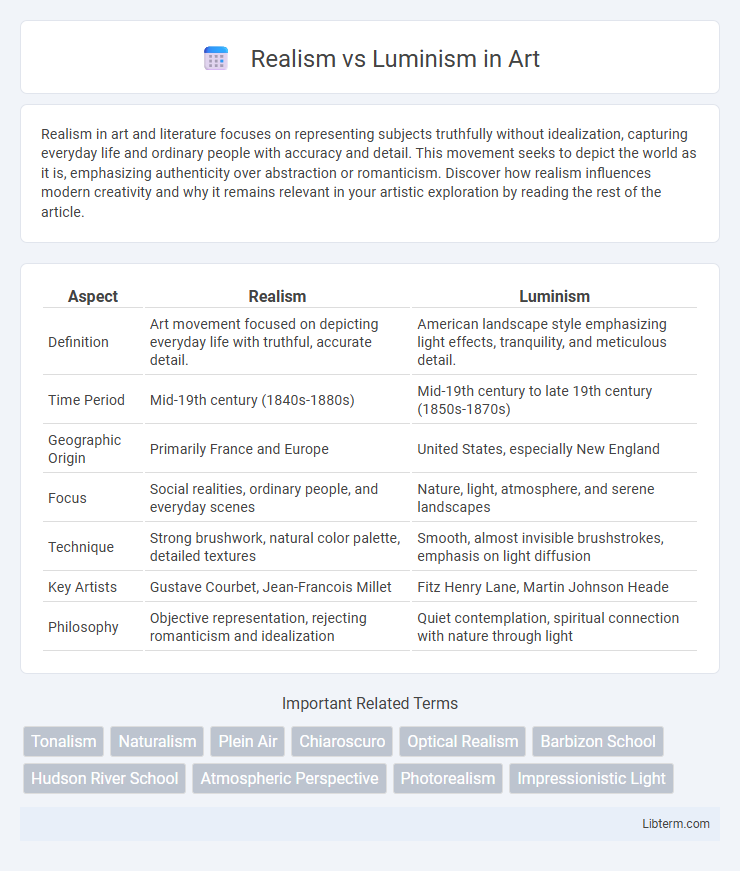Realism in art and literature focuses on representing subjects truthfully without idealization, capturing everyday life and ordinary people with accuracy and detail. This movement seeks to depict the world as it is, emphasizing authenticity over abstraction or romanticism. Discover how realism influences modern creativity and why it remains relevant in your artistic exploration by reading the rest of the article.
Table of Comparison
| Aspect | Realism | Luminism |
|---|---|---|
| Definition | Art movement focused on depicting everyday life with truthful, accurate detail. | American landscape style emphasizing light effects, tranquility, and meticulous detail. |
| Time Period | Mid-19th century (1840s-1880s) | Mid-19th century to late 19th century (1850s-1870s) |
| Geographic Origin | Primarily France and Europe | United States, especially New England |
| Focus | Social realities, ordinary people, and everyday scenes | Nature, light, atmosphere, and serene landscapes |
| Technique | Strong brushwork, natural color palette, detailed textures | Smooth, almost invisible brushstrokes, emphasis on light diffusion |
| Key Artists | Gustave Courbet, Jean-Francois Millet | Fitz Henry Lane, Martin Johnson Heade |
| Philosophy | Objective representation, rejecting romanticism and idealization | Quiet contemplation, spiritual connection with nature through light |
Introduction to Realism and Luminism
Realism emerged in the mid-19th century, emphasizing accurate, detailed, and unembellished depictions of everyday life and ordinary people, often highlighting social issues and the human condition. Luminism, a 19th-century American art movement, focused on the precise rendering of light and atmosphere, characterized by calm, reflective landscapes and meticulous attention to natural light effects. While Realism stresses truthful representation and social context, Luminism prioritizes mood and the sublime quality of light in nature.
Defining Realism: Key Characteristics
Realism emphasizes depicting everyday life with accurate, detailed, and unembellished representation, focusing on ordinary subjects and social realities. It rejects idealization and romanticism, striving for truthful portrayal of contemporary life and conditions. Key characteristics include precise brushwork, natural color palettes, and emphasis on light and shadow to enhance the authenticity of scenes.
Luminism Explained: Features and Style
Luminism, an American art movement of the mid-19th century, emphasizes meticulous attention to light effects, clarity, and tranquility in landscape paintings. Characterized by smooth surfaces with invisible brushstrokes and a soft, diffused light, Luminism captures atmospheric conditions to evoke a sense of calm and introspection. Unlike Realism's focus on everyday subjects and detailed accuracy, Luminism prioritizes the spiritual experience of nature through serene compositions and harmonious color palettes.
Historical Origins of Realism
Realism emerged in the mid-19th century as a reaction against Romanticism, emphasizing accurate, unidealized depictions of everyday life and social conditions. Rooted in the political and social upheavals of 1848 Europe, Realism sought to portray ordinary people with truthful detail, often highlighting the working class and rural landscapes. Prominent artists such as Gustave Courbet and Jean-Francois Millet pioneered this movement, influencing subsequent art styles by prioritizing objective observation and straightforward representation.
The Emergence of Luminism
Luminism emerged in mid-19th century America as a distinct offshoot of Realism, emphasizing meticulous attention to light and atmosphere in landscape painting. Unlike Realism's focus on detailed, unembellished depiction of everyday scenes, Luminism highlights tranquility and clarity, using smooth brushwork and subtle gradations to capture natural light effects. Prominent artists like Fitz Henry Lane and Martin Johnson Heade pioneered this style, shaping the visual narrative of American art by portraying serene, luminous waterscapes and skies with refined luminosity.
Major Artists in Realism
Realism, emerging in the mid-19th century, was championed by artists such as Gustave Courbet, Jean-Francois Millet, and Edouard Manet, who emphasized depicting everyday life with raw honesty and social commentary. Luminism, primarily an American movement led by painters like Fitz Hugh Lane and John Frederick Kensett, focused on the precise portrayal of light effects and serene landscapes using meticulous brushwork and a soft, glowing palette. While Realism captures the gritty truth of human experience and societal issues, Luminism highlights luminous atmospheres and tranquil natural scenes.
Prominent Luminist Painters
Prominent Luminist painters such as Fitz Henry Lane, Martin Johnson Heade, and John Frederick Kensett emphasized meticulous detail and a serene atmosphere, distinguishing Luminism from Realism's broader focus on everyday life and naturalistic representation. Their works capture light's subtle effects on landscapes and seascapes, employing smooth brushwork and refined color gradients to evoke tranquility and spiritual contemplation. Unlike Realism's focus on social realities, Luminism prioritizes the interplay of light and nature to convey mood and transcendence.
Techniques: Realism vs Luminism
Realism emphasizes detailed, accurate depictions of everyday life using precise brushwork and natural colors to capture authentic scenes. Luminism prioritizes the study of light effects with smooth, almost invisible brushstrokes and soft tonal transitions to create serene, luminous atmospheres. Techniques in Luminism highlight atmospheric clarity and tranquility, whereas Realism focuses on texture and form to portray the tangible reality of subjects.
Thematic Differences and Similarities
Realism and Luminism both emphasize detailed depictions of everyday scenes, but Realism focuses on social conditions, human struggles, and political commentary, while Luminism highlights the effects of light and atmosphere to evoke tranquility and mood. Both movements share a commitment to naturalism and precise representation, yet Realism often portrays broader human experiences, whereas Luminism concentrates on landscapes imbued with emotional quietude. Thematically, Realism confronts reality's harshness, whereas Luminism celebrates nature's serene beauty.
Impact and Legacy in Art History
Realism revolutionized 19th-century art by emphasizing truthful depictions of everyday life, challenging the idealized subjects of previous movements and influencing social and political discourse. Luminism, characterized by meticulous attention to light and atmosphere, advanced landscape painting in America, inspiring later Impressionists and reinforcing the connection between nature and emotion in art. Both movements left enduring legacies: Realism shaped modern artistic narratives with its authenticity, while Luminism enriched visual techniques and thematic depth through its nuanced portrayal of natural light.
Realism Infographic

 libterm.com
libterm.com